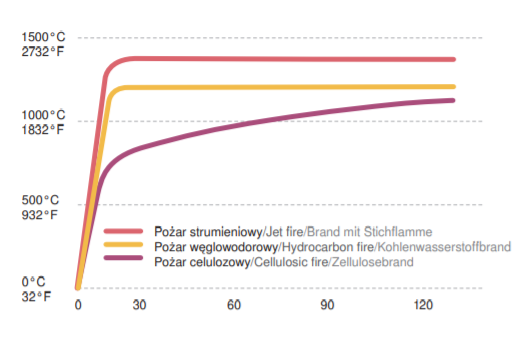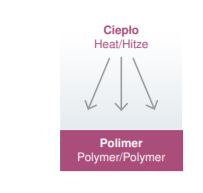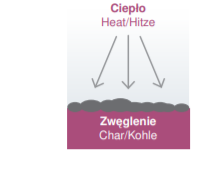Due to numerous fire incidents in public places or industrial areas that took place in the past, fire protection has become a key issue. Currently, there are many specialised solutions for increasing the material resistance to fire.

Is every fire the same dangerous?
Fires vary due to the amount of heat released to the environment, which means due to the temperature of the event. Residential buildings and public places (offices, concert halls, hospitals, sports facilities, shopping centres) are exposed to temperatures of around 600°C just after 5 minutes of fire. On the other hand, during the fire due to ignition of fuel (petroleum, gas) the ambient temperature after 5 minutes can be up to 1100°C. The former type of fires is called cellulosic fire, the latter is hydrocarbon fire. A particular case of hydrocarbon fire is jet fire, which results from the ejection of a highly flammable liquid, the temperature is then above 1200°C. To provide security and property protection there are used advanced solutions. In buildings that are exposed to cellulose fire, protection is less demanding than for industrial structures that are particularly exposed to hydrocarbon fires.

Chart 1. Change in temperature over time caused by different types of fire
Source: PPG Protective & Marine Coatings, broszura PITT-CHAR XP – The ultimate solution for extreme hydrocarbon fire scenarios
What is passive protection of buildings and steel structures?
One of the fire protection methods is to increase the fire resistance of building structures (the time during developed fire at which building elements retain their usefulness). Thanks to this method, the moment of complete destruction of the building is delayed, thus prolonged the time of rescue operation. This kind of protection is defined as passive protection. Passive protection includes, among others, coating of steel structures with highly specialised fire protection paints. The most important are intumescent coatings. Under fire conditions, the intumescent paints increase their volume several times, forming on the Surface of metal a layer of char with protective and insulating properties. As a result, the steel temperature rise is reduced and therefore the load capacity of the structure can be maintained up to 4 hours. Such solutions are required on drilling platforms, flammable liquid storage facilities, petrochemical plants, refineries, LPG terminals and shipbuilding.
How do intumescent coatings work?
Fire retardant paint properties are obtained by using appropriate additives in formulations. For intumescent paints it is necessary to use at least three types of additives with a strictly defined function that together form a protective layer.
| PROCESS: | ||
| phosphoric acid secretion due to thermal decomposition of phosphoric component | formation of carbon layer by phosphoric acid reaction with carbon source additive | intumescence of carbon layer by gas evolution |
 |
 |
 |
| FUNCTIONAL ADDITIVE | ||
| source of acid (e.g. ammonium polyphosphate, phosphate ester) | carbon source (e.g. pentaerythritol) | expanding agent (e.g. melamine) |
PCC Rokita solutions for intumescent paints
The Phosphorus Chemical Complex’s offer includes, among others, products dedicated to intumescent paints designed primarily to protect steel structures against hydrocarbon fires. The most popular solution of the world’s largest manufacturers of fire protection paints is Roflam B7. The product combines the function of a flame retardant and viscosity reducer, becoming a very important component of intumescent paints.
In order to keep up with growing demands of the paint market, PCC Rokita portfolio was expanded with Roflam B7L flame retardant. This product is completely safe for the environment and human health. Compared to other products from phosphorus aryl esters group, it is distinguished by lack of hazard classification according to GHS system. Thanks to these advantages, the additive may be used in eco-friendly products.
Aleksandra Marek
Technical Service Specialist
Kamil Cieślak
Technical Service & Product
Development Manager PCC Rokita